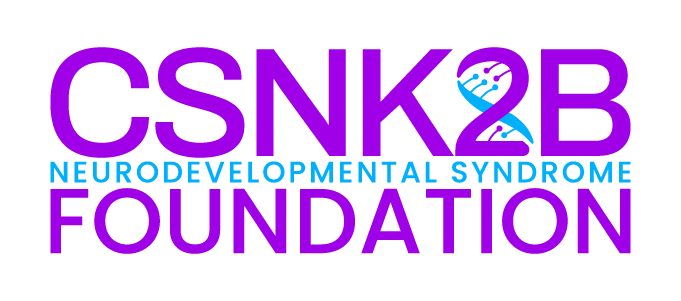What is CSNK2B?

-
Summary
CSNK2B Neurodevelopmental Disorder is caused by variants in the CSNK2B gene. Most affected individuals have one or more of the following symptoms: Epilepsy (disposed to having seizures) Developmental delay and/or Intellectual disability CSNK2B is also called Poirier–Bienvenu neurodevelopmental Disorder (POBINDS).
-
Description
Symptoms of CSNK2B Neurodevelopmental Syndrome often start in the first few years of life. Families may seek medical advice because of delays in their child’s development and/or because of seizures. Symptom severity differs greatly from patient to patient. Some individuals are very severely affected (unable to speak or walk and/or have seizures that do not respond to treatment) but others are much more mildly affected (learning disability and/or seizures that respond to treatment).
-
Signs and Symptoms
CSNK2B Neurodevelopmental Disorder symptoms include: Epilepsy (disposed to seizures). Affected individuals may have focal or generalized seizures. Seizures often start in the first few years of life. Seizures starting in the first six months is common. Seizures can result in complications: Status epilepticus (prolonged seizure) puts individuals at risk for brain damage and medical complications. SUDEP (sudden unexpected death in epilepsy patients). Seizures can put individuals at risk for death. Developmental delay. Children may be late to meet some developmental milestones – for instance, they may walk late – or they may fail to meet some milestones– for instance, they may not ever learn to speak. Relatedly, some children have: Coordination difficulty – Trouble coordinating their body’s movements. Low muscle tone (they are floppy) often occurs together with delays in motor milestones, such as sitting. Intellectual disability. Individuals may have differences in intellectual functioning that range from severe (not being able to understand speech, for example) to minor differences from other children. Related diagnoses or symptoms include: Learning disability Autism Spectrum Disorder or autistic symptoms Attention-Deficit Hyperactivity Disorder Psychiatric or behavioral problems Physical differences. Some individuals have one or more of the following: Short stature Fingers/toes – differences in the appearance of the fingers or toes Facial features – wide and/or deep-set eyes, broad and/or depressed bridge of the nose, broad forehead, thin upper lip, pointed chin, protruding jaw, and ear differences Teeth – missing or atypical appearing teeth
SUMMARY
CSNK2B Neurodevelopmental Disorder is caused by variants in the CSNK2B gene.
Most affected individuals have one or more of the following symptoms:
- Epilepsy (disposed to having seizures)
- Developmental delay and/or Intellectual disability
CSNK2B is also called Poirier–Bienvenu neurodevelopmental Disorder (POBINDS).
DESCRIPTION
Symptoms of CSNK2B Neurodevelopmental Syndrome often start in the first few years of life. Families may seek medical advice because of delays in their child’s development and/or because of seizures.
Symptom severity differs greatly from patient to patient. Some individuals are very severely affected (unable to speak or walk and/or have seizures that do not respond to treatment) but others are much more mildly affected (learning disability and/or seizures that respond to treatment).
SIGNS AND SYMPTOMS
CSNK2B Neurodevelopmental Disorder symptoms include:
- Epilepsy (disposed to seizures). Affected individuals may have focal or generalized seizures. Seizures often start in the first few years of life. Seizures starting in the first six months is common. Seizures can result in complications:
- Status epilepticus (prolonged seizure) puts individuals at risk for brain damage and medical complications.
- SUDEP (sudden unexpected death in epilepsy patients). Seizures can put individuals at risk for death.
- Developmental delay. Children may be late to meet some developmental milestones – for instance, they may walk late – or they may fail to meet some milestones– for instance, they may not ever learn to speak. Relatedly, some children have:
- Coordination difficulty – Trouble coordinating their body’s movements.
- Low muscle tone (they are floppy) often occurs together with delays in motor milestones, such as sitting.
- Intellectual disability. Individuals may have differences in intellectual functioning that range from severe (not being able to understand speech, for example) to minor differences from other children. Related diagnoses or symptoms include:
- Epilepsy (disposed to seizures). Affected individuals may have focal or generalized seizures. Seizures often start in the first few years of life. Seizures starting in the first six months is common. Seizures can result in complications:
- Learning disability
- Autism Spectrum Disorder or autistic symptoms
- Attention-Deficit Hyperactivity Disorder
- Psychiatric or behavioral problems
- Physical differences. Some individuals have one or more of the following:
- Short stature
- Fingers/toes – differences in the appearance of the fingers or toes
- Facial features – wide and/or deep-set eyes, broad and/or depressed bridge of the nose, broad forehead, thin upper lip, pointed chin, protruding jaw, and ear differences
- Teeth – missing or atypical appearing teeth
CAUSES
CSNK2B Neurodevelopmental Disorder is a genetic disease, meaning that it is not caused by anything anyone did or did not do.
Most cases result when a variant in CSNK2B has spontaneously occurred in the child. In other words, the variant was not inherited from a mother or father but is new and only in the affected child. Less often, disease causing variants in CSNK2B can be inherited from an affected or unaffected parent. In either case, CSNK2B Neurodevelopmental Disorder is “autosomal dominant,” meaning that only one of two copies of CSNK2B needs to be abnormal to result in disease.
LABORATORY INVESTIGATIONS
Genetic testing will show a disease-causing variant in the CSNK2B gene.
Other tests that may be performed include:
- Electroencephalography (EEG), which is helpful in understanding the kind of seizures a patient has
- Neuropsychological testing, which helps with understanding a child’s cognitive strengths and weaknesses (whether there is intellectual disability or learning disability for example)
TREATMENT AND THERAPIES
Treatment of CSNK2B Neurodevelopmental Disorder is based on what symptoms an individual has.
- Developmental delay. Therapies during childhood to assist children in meeting their developmental milestones:
- Speech therapy
- Occupational therapy
- Physical therapy
- Developmental delay. Therapies during childhood to assist children in meeting their developmental milestones:
- Epilepsy. Prevention of seizures and medicine to stop a prolonged seizure to help reduce the risk of complications from seizures. Treatment is for as long as the risk of seizures is present.
- Anti-seizure medication(s) for as long as the disposition to seizures lasts. Particular medication depends on the type of seizures the patient has. Potential side effects depends on the particular medication.
- Short stature
- Some patients have been treated with growth hormone during childhood by an endocrinologist
OUTLOOK
Outcomes in CSNK2B Neurodevelopmental Disorder differ greatly from patient to patient with some individuals severely affected and others more mildly affected. Most but not all patients are able to walk as adults. Many patients have some intellectual disability, and some patients remain unable to speak. Epilepsy severity and outcome also differs between patients.
RELATED DISORDERS
CSNK2B is one of many genes with variants that result in neurodevelopmental symptoms and/or epilepsy. These conditions are often referred to as “genetic epilepsies” or “genetic developmental and epileptic encephalopathies” or as “complex neurodevelopmental disorders.”
REFERENCES
CSNK2B Website: https://www.csnk2b.org
CSNK2B Foundation: https://www.facebook.com/csnk2bfoundation/
Facebook page for families: https://www.facebook.com/groups/122003328716298/
Contact Tristan Sands, MD, PhD at Columbia University ([email protected]) for information about ongoing research.
We will also be able to reference a GeneReview soon!

